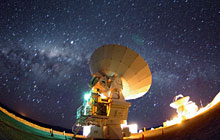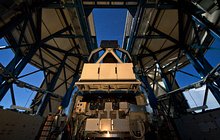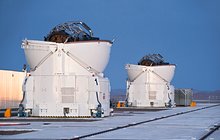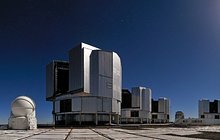|
|

|
28 November 2013: ALMA proposals for Cycle 2 have been arriving since the publication of the Call for Proposals on 24 October 2013. ALMA Early Science Cycle 2, will start in June 2014. This Call provides an important opportunity for Early Science from this cutting-edge facility. The Cycle 2 period will span 17 months and users of any professional background, nationality, ...
|
| Read more |

|
28 November 2013: ATLAS is a ugriz imaging survey targeting ~4500 square degrees of the southern sky with the VLT Survey Telescope (VST). Data products resulting from the first release of the ATLAS public survey are now available via the dedicated Phase 3 query interface at the ESO Science Archive Facility. This data release consists of the stacked reduced ...
|
| Read more |

|
28 November 2013: A public interferometric survey of the gaseous circumstellar environments of hot stars is being conducted. It is named OHANA — the Observatory survey at High ANgular resolution of Active OB stars. The survey is a bad weather/filler programme currently carried out by the VLTI group at the Paranal Observatory. The targets are selected from three classes: Be stars; supergiants and ...
|
| Read more |

|
28 November 2013: The PIONIER science meeting will be held on 13–14 January 2014, followed by the VLTI community days (15–16 January), and is organized by IPAG, ESO and Eii. The spirit of the meeting is to provide a direct way for the community to exchange ideas with those at ESO who take care of the VLTI. The latest VLTI results will ...
|
| Read more |
Upcoming ESO or ESO-Related Workshops
- Science with the Atacama Pathfinder Experiment (APEX)
Ringberg Castle, Germany, 19 - 22 January 2014
The 2nd APEX science meeting will cover the broad range of science results from APEX, from the Solar System to distant galaxies, with particular attention given to the synergy with Herschel, ALMA and SOFIA. The meeting will also give a preview of upcoming new instrumentation at APEX. The registration deadline is 15 December 2013.
- Exoplanet Observations with the E-ELT
Auditorium, ESO Garching, 3 - 6 February 2014
Exoplanet research is one of the major science drivers for the future European Extremely Large Telescope (E-ELT). This community workshop will explore the science cases and the planned capabilities of the E-ELT in the field of exoplanet research. The aim is to provide a synthesis of the goals to be achieved by the E-ELT with its planned instrumentation in the field of exoplanets and the most relevant issues in exoplanet science for the next decade. Topics to be discussed include: initial conditions for planet formation; planetary populations determined from detection surveys; characterisation through resolved imaging and direct and transit spectroscopy; the search for habitable planets.
- 3D2014 - Gas and stars in galaxies: A multi-wavelength 3D perspective
Garching, 10 - 14 March 2014
This workshop aims to bring together the optical/near-infrared, millimetre and radio communities working on 3-dimensional extragalactic data, following on from the similarly themed 2008 workshop. Science topics are centered on both gas and stars in galaxies and examples include dynamics, AGN and supermassive black holes, high redshift galaxies and deep fields. Tools to visualise and analyse multi-wavelength data cubes will also be discussed. In association with the workshop, three parallel user workshops on reduction and analysis of 3D data from KMOS, MUSE and ALMA will be held. Further details can be found here. The abstract and registration deadline is 1 December 2013.
- Astrotomography II - Imaging at the Micro-arcsecond Scale
Santiago, ESO Santiago, 1 April 2014
This workshop, which should have taken place in December has been postponed until further notice. It will likely take place in April or May 2014. Date is not yet fixed.
Astrotomography is a generic term for indirect mapping techniques that can be applied to a huge variety of astrophysical systems, ranging from planets, through single stars and binaries to active galactic nuclei. Given the increase in scientific output of astrotomography, it is timely to review the methods, chart progress in the field and prepare the next generation of astronomers to use the tools. The workshop themes will cover computational methods, techniques and new developments, new instrument possibilities and applications. In addition to reviews and contributed talks, an additional day is planned with a hands-on training workshop. Further details are available by contacting the organisers at tomo2013@eso.org.
- Herbig Ae/Be Stars: The Missing Link in Star Formation
Santiago, ESO Santiago, 7 - 11 April 2014
Herbig Ae/Be (HAeBe) stars are a class of early-type pre-main sequence objects whose stellar mass corresponds to the transition regime between Solar-type stars and high-mass stars. They are generally bright at most wavelengths allowing a detailed view of their evolving environment and are pivotal objects for the formation of both stars and planets. The high-resolution observational and theoretical advances of the past 10 to 15 years provide the primary motivation and the evolution of the circumstellar disk material constitutes the main, but not the exclusive topic, for the workshop. Areas to be addressed include circumstellar disk structure, transition and debris disks, disk dispersal, jets and outflows, young clusters and the impact of future instrumentation.
This workshop will commemorate the life and work of George H. Herbig (2 January 1920 - 12 October 2013). Herbig pioneered the field of star formation, especially that of young stars and their nebulous surroundings. A brief appreciation of his life and work can be found at http://www.ifa.hawaii.edu/info/press-releases/Herbig/
- The Formation and Growth of Galaxies in the Young Universe
Obergurgl, Austria, 26 - 30 April 2014
It is now about 4 years since the last galaxy evolution ski conference at the University of Innsbruck Obergurgl Center. Since then several major surveys have been completed by Hubble and Herschel, wide-field near-infrared imaging has been delivered by VISTA, SCUBA2 has commenced sub-mm surveys on the JCMT, near-infrared multi-object spectrographs have commenced operation on 8-m class telescopes, and the first results have emerged from ALMA and Planck. The aim of this meeting will be to review and discuss these observational advances, alongside progress in theory/simulation, with a dual focus on galaxy/black-hole evolution at z > 2 and reionization/first-galaxies at z > 6.
The meeting will consist of invited and contributed talks and there will space for posters. Each day will be split to allow ~4 hours for lunch/skiing/scientific discussion between 12pm and 4pm. More details here.
|
|
|
|
|
|
|
|